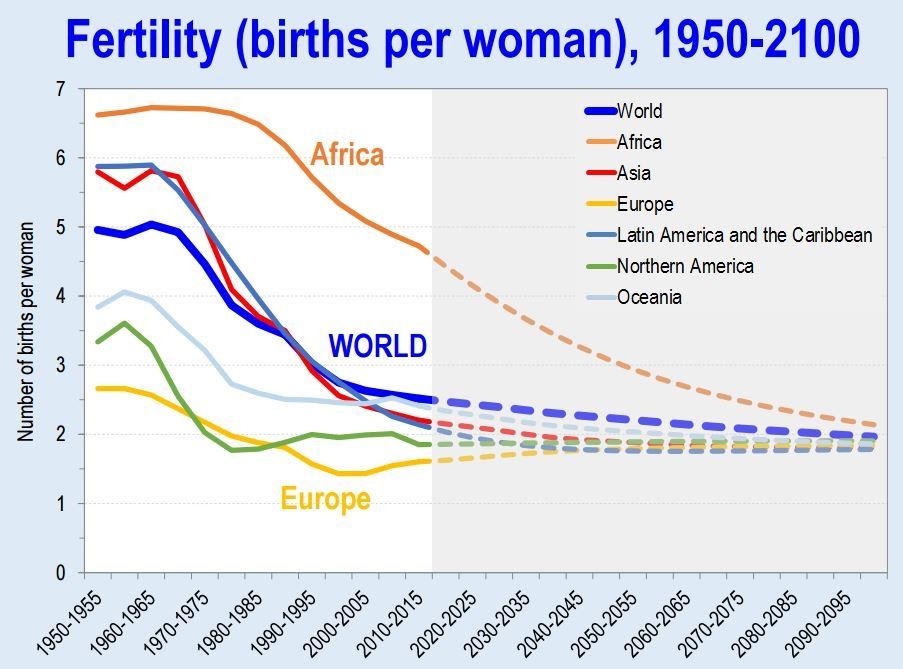11 facts about the world's changing population

Passengers travel in an overcrowded train near a railway station at Loni town. Image: REUTERS/Anindito Mukherjee

Get involved with our crowdsourced digital platform to deliver impact at scale
Stay up to date:
Youth Perspectives
Every year, the world’s population is expanding by 83 million people. Right now, there are around 7.6 billion people in the world. By 2050, there will be just short of 10 billion.
But population trends are wildly uneven - some countries are rapidly expanding, others are shrinking.
Each scenario brings its own challenge for governments. Countries whose populations are declining have to think about how to support older people when there fewer young workers to pay into government funds. Countries with a booming young population have to grapple with how to feed them and provide education and healthcare.
Three major things affect population. Fertility is the main factor, followed by mortality and then migration.
Here are some key facts about the world’s population, taken from the latest UN World Population Prospects.
1. By 2024 India will overtake China as the world’s most populous country
China currently has 1.4 billion inhabitants, closely followed by India with 1.3 billion. Together they make up 37% of the world’s population.
2. Nigeria has the world’s fastest growing population
Nigeria is currently 7th on the list of most populous countries, but before 2050 it will have made third place, overtaking the US.
1 China 1 397 029
2 India 1 309 054
3 United States of America 319 929
4 Indonesia 258 162
5 Brazil 205 962
6 Pakistan 189 381
7 Nigeria 181 182
8 Bangladesh 161 201
9 Russian Federation 143 888
10 Japan 127 975
3. Fertility has fallen all over the world
Since the 1960s, the global birth rate has fallen to an average of 2.5 births per woman. However, that average is made up of highly diverse figures: in Africa its 4.7 births per woman, in Europe it’s 1.6 births per woman.

4. Half of the population growth will take place in 9 countries
From 2017 to 2050, India, Nigeria, the Democratic Republic of the Congo, Pakistan, Ethiopia, the United Republic of Tanzania, the United States of America, Uganda and Indonesia will contribute the most to population growth.
This means that the population of Africa is set to roughly double between now and 2050.

5. Europe’s population will decline
When fertility falls below 2.1 births per woman it’s deemed “below‐replacement”. That means that not enough babies are being born to replace their parents’ population. This is already happening in Europe.
6. Almost half the world’s population live in countries with low fertility
Between 2010 and 2015, 46% of the world’s population lived in 83 countries where the fertility level was below the threshold of 2.1.
7. The world is getting older
An increasing number of people are living to a ripe old age. In 1950, there were far more young than old. In 2017, there are fewer young and more older people. By 2050, the numbers will even out.

8. We are living longer
Overall, life expectancy is increasing. On a global level, life expectancy at birth rose by almost 4 years, or from 67 to 71 years, between 2000 and 2015.
It is projected to rise to around 77 years in the period between 2045 and 2050, and eventually to 83 years in the period between 2095 and 2100.
9. Differences in life expectancy will get less pronounced
Life expectancy in Africa was 60 years between 2010 and 2015, compared to 79 years in Northern America. But life expectancy is rising faster in Africa than Europe, so the difference is expected to decrease significantly by 2050.
10. Africa still has a relatively young population, the same can’t be said for Europe
In 2017, 60% of the African population is under the age of 25, only 5% are 60 or older. In Europe, only a quarter of the population is under 25. Another quarter are 60 or older.

11. Net migration is declining
Between 1950 and 2015, Europe, Northern America and Oceania, more people immigrated in than migrated out.
Africa, Africa, Asia and Latin America and the Caribbean had more people leave than enter.
Migration peaked in 2005-2010 to 4.5 million people per year moving between major regions of the world. Between 2010 and 2015 the figure was 3.2 million.
For countries with low fertility rates, migration may be the only way to avert population decline.

Understanding each country’s demographic is key to reaching the UN’s Sustainable Development Goals, says John Wilmoth, Director, Population Division, Department of Economic and Social Affairs, United Nations.
Those goals include reducing poverty, hunger and inequality in the world.
By tracking the populations governments can implement policies and initiatives to overcome the challenges they face.
Don't miss any update on this topic
Create a free account and access your personalized content collection with our latest publications and analyses.
License and Republishing
World Economic Forum articles may be republished in accordance with the Creative Commons Attribution-NonCommercial-NoDerivatives 4.0 International Public License, and in accordance with our Terms of Use.
The views expressed in this article are those of the author alone and not the World Economic Forum.
Related topics:
The Agenda Weekly
A weekly update of the most important issues driving the global agenda
You can unsubscribe at any time using the link in our emails. For more details, review our privacy policy.
More on Youth PerspectivesSee all
Andrew Moose and Ruma Bhargava
April 5, 2024
Tomoko Fukuda and Andreas Daugaard Jørgensen
March 4, 2024
Simon Torkington
January 31, 2024
Catherine Russell
January 17, 2024






